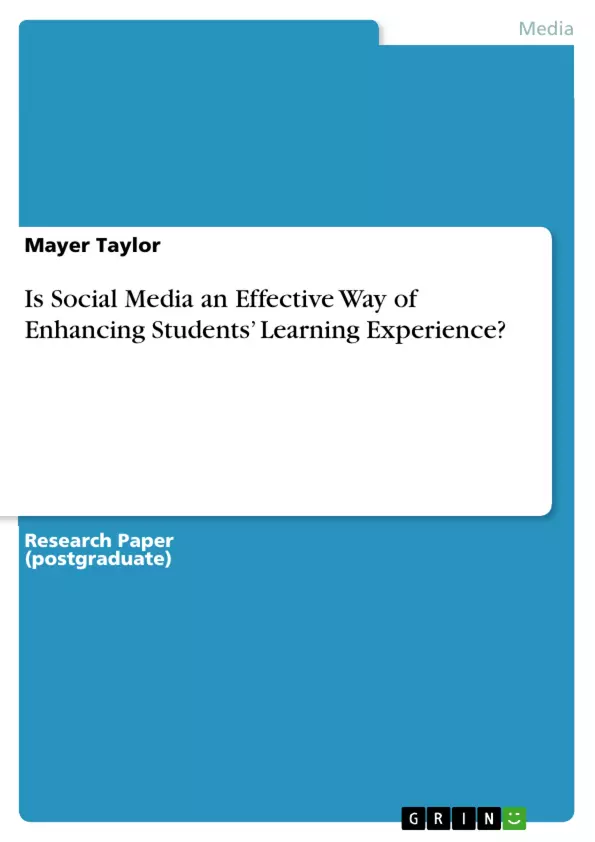The emergence and widespread popularity of social media usage has revolutionized the way in which the young generation communicates, connects and socializes now a day. This has had significant implications for higher education and learning due to the changing nature of students entering higher education institutions now a days and the changing nature of communication and connections; all of which impact upon the learning behavior and academic activities of students.
Higher education institutions are faced with an imperative challenge in that they are required to respond to the phenomenon of social media integration in higher education. It is high time for higher education institutions to formulate viable social media strategy to ensure that the contemporary learning environment and teaching approaches reflect the changing nature of younger generation. This research identifies the impact of social media upon students’ overall learning experience and ways in which social media adds value to the students’ learning experience.
This study utilizes survey and interview methods for primary data collection to study a group of student at Brunel University in UK. Based on the research findings, it is concluded that social media usage has a significant positive impact upon enabling student’s collaboration in context of group work, enabling delivery of assessment and feedbacks and other course related content and fostering formal communication between students and tutors. Within these broader domains, establishing sense of community, facilitating multidisciplinary intergroup communication, facilitating sharing of student-generated content and general discussion between tutors and students were some of the most enabling aspects of social media usage.
Despite the positive role of social media for these purposes, the research findings also reveal that there are several shortcomings related to social media usage which impede the effectiveness of social media in positively affecting students’ overall learning experience such as the lack of commitment of peers to use of social media for formal communication and learning, the inability or unwillingness of tutors/instructors to utilize social media and privacy concerns.
Inhaltsverzeichnis (Table of Contents)
- Abstract
- Introduction
- Background of the Study
- Aim and Objectives
- Research Questions
- Literature Review
- Popularity of Social Networking Websites Millennials
- Social Media and New Types of Learners
- Connecting Students through Social Media
- Types of Social Media Usage
- The Importance of Research
- Research Methodology
- Research philosophy
- Research approach
- Research purpose
- Research strategy
- Data Collection
- Research design
- Hypotheses
- Population of the Study
- Sampling Method
- Ethical Considerations
- Findings and Analysis
- Research Findings
- Reliability of the Results
- Bivariate Correlation
- Analysis of Interview Responses
- Hypothesis Testing
- Discussion
- Conclusion
- Research Contributions
- Implications of this Research
- Limitations of this Research
- Suggestions for Future Research
- References
- Appendix A
- Questionnaire
- Section A
- Section B
- Section C
- Qualitative Interview Questions
- Questionnaire
- Appendix B
- Appendix C
Zielsetzung und Themenschwerpunkte (Objectives and Key Themes)
This study aims to explore the impact of social media on student learning experiences and identify ways in which social media can enhance these experiences. It is focused on examining the potential benefits and limitations of social media integration in higher education, considering the perspectives of students at Brunel University in the UK.- The positive impact of social media on student collaboration, assessment delivery, and communication.
- The role of social media in fostering a sense of community and facilitating interdisciplinary communication among students.
- The challenges associated with social media use in education, such as lack of peer commitment, tutor reluctance, and privacy concerns.
- The potential of social media to support student-generated content and broader discussions between students and tutors.
- The development of effective social media strategies for higher education institutions.
Zusammenfassung der Kapitel (Chapter Summaries)
The Introduction chapter sets the context by discussing the growing influence of social media on the young generation and its implications for higher education. It highlights the need for institutions to adapt to the changing landscape of communication and learning, emphasizing the importance of social media integration. The Literature Review chapter provides a comprehensive overview of existing research on social media usage in education. It examines topics such as the popularity of social networking platforms among millennials, the characteristics of new types of learners in the digital age, and various types of social media usage in educational settings. It also underscores the importance of research in understanding the role of social media in higher education. The Research Methodology chapter details the research design and methods employed in the study. It outlines the philosophical and methodological underpinnings, including the research approach, purpose, strategy, and data collection techniques. The chapter also discusses the ethical considerations involved in conducting the research. The Findings and Analysis chapter presents the results of the study, including the analysis of survey and interview data. It examines the relationship between social media usage and student collaboration, assessment, communication, and overall learning experience. This chapter also includes a discussion of the limitations and implications of the findings.Schlüsselwörter (Keywords)
Social media, higher education, student learning experience, collaboration, assessment, communication, community building, interdisciplinary communication, digital learners, research methodology, qualitative research, quantitative research, data analysis, limitations, implications, future research.- Quote paper
- Mayer Taylor (Author), 2011, Is Social Media an Effective Way of Enhancing Students’ Learning Experience?, Munich, GRIN Verlag, https://www.grin.com/document/267071



